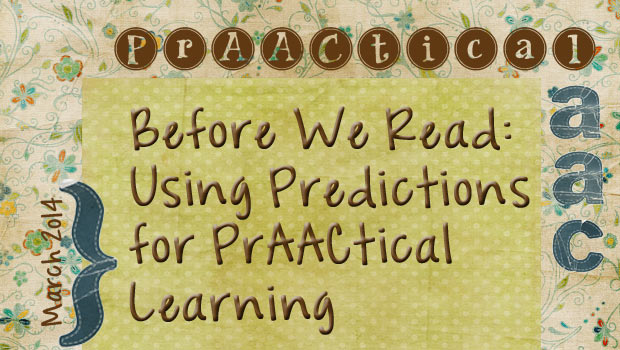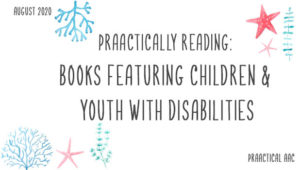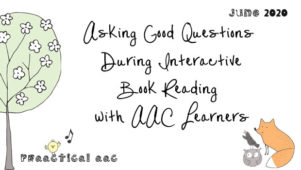Before We Read: Using Predictions for PrAACtical Learning

This month, we’re focusing on literacy learning for our Monday posts on Strategy of the Month. In honor of that topic, here’s a quick tip for adding a bit of interaction to book reading. This tip works for books you’ve never read before, or perhaps haven’t read in a really long time.
Take a few minutes before the reading begins to predict what the book will be about. We’ll get to the ‘How To’ part in a minute, but first, here’s why we think this is a prAACtical idea.
- It gets AAC learners thinking about something more than requesting, and we know you are just as passionate about that as we are.
- It helps the AAC learner activate their background knowledge, something that (we’ve noticed) many of them don’t do automatically. That doesn’t mean that they aren’t capable of it, of course, but it does mean they need practice and support in learning do to this. The more that we offer, the more we are strengthening those skills so that it becomes habitual, and that gives them a real boost in their learning.
- It is what good readers do. Active reading strategies help us process and retain information. Making predictions is a good entry point into active reading and learners who are used to doing that, may find it easier and more natural to use other active reading strategies later on when they get to expository text.
- It provides another opportunity to practice core vocabulary. No matter what the topic, there will surely be an opportunity to use core words in the prediction. E.g., I, it, they, think, do, go, see, with, in, there, etc. You get the idea.
- It helps build inferencing skills. We love teaching AAC communicators to develop their ability to make inferences, a pivotal skill that impacts academics, social skills, and independent living. Without intervention, children who use AAC often draw faculty conclusions from things they observe. Making predictions gives us an opportunity to examine our inferences and the ways in which we arrive at them.
- It serves as a warm-up to interaction while reading. Once we’ve made some predictions using our AAC, we’re in the mindset that reading isn’t a passive experience. We’re not only ready for interaction, but we’ve already used some of the vocabulary that will be used in those conversations.
- It offers a chance for us to use aided language input, a critical strategy for beginning communicators.
- It gives us a chance to model writing. As we make some predictions, we’ll jot them down so that we can check back to see if we were right after we’ve finished reading. Writing for an authentic purpose? We can never get enough of that.
- It’s fun (and that’s no small thing). For kids to be engaged in reading and communicating, there has to be some level of enjoyment. We can boost the ‘fun factor’ with a playful mindset and curious attitude.
Making predictions is simple and takes only an extra few minutes. It can be a formal part of the way we introduce new books in therapy/school, or a casual part of the ‘let’s read’ conversation at home. There are lots of ‘right’ ways to do this. Here is one of them.
- Use think-aloud to begin to establish the expectation. E.g., “I wonder what this book is about.”
- Make the expectation more explicit. E.g., “Let’s look at it before we read and make a guess.”
- Look at the cover and/or page through the book and talk about what you see.
- Make some guesses
- Write them down. It could be as simple as a list on scrap paper or a more specific
- Read the book.
- Go back to the predictions to see which were right and wrong.
Want to read more about making predictions as part of literacy instruction? Here are some links for you.
- Predicting by TeacherVision
- Guided Reading Activities-Making Predictions by K12 Reader
- Make Predictions by BrainPop Educators (We’ve written about BrainPop here.)
Do you work with AAC learners on making predictions? We’d love to hear about your experiences.
Filed under: PrAACtical Thinking
Tagged With: literacy, predictions, reading, writing
This post was written by Carole Zangari





4 Comments
HI Carole,
Predicting has also been really successful for many of the students we work with in helping them to understand that text always has meaning. Helps to avoid or reduce reading without comprehension which is fabulous.
Thanks for a great blog post 🙂
Jane
That’s such a good point, Jane. Another benefit that I’ve seen relates more to how others percieve ‘our’ kids. When they hear/see us asking these kinds of questions, and see/hear the kids responding, it helps them realize how much these kids are capable of with enough good instruction. Thanks for taking the time to share those thoughts, Jane.
We are working on a series of worksheets that would work hand-in-hand with this skill. Boy, it’s tough for even our seasoned educators to answer some of the question we have seen in State level samples. We find that students struggle unless the outline and then re-read the passage.
Very frustrating to hear that, Nancy (on many levels!). Thanks for taking the time to share the info, though. Much appreciated!